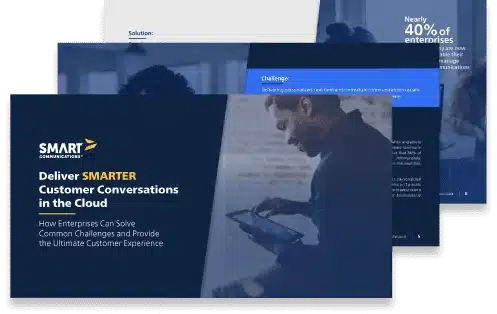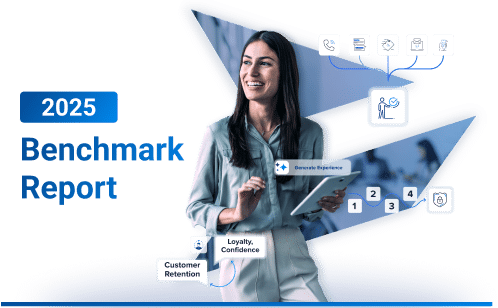7 Questions to Ask a New Vendor Before Switching from Legacy to Cloud CCM Software
By: Brad McGeown, Vice President of Strategy, Financial Services at Smart Communications
Making the most out of every customer interaction is an essential part of any enterprise and having the right SaaS Customer Communications Management (CCM) software in place makes a big difference as organizations across all industries continue to focus their investments into sophisticated tech that enables their workforces to be more agile, efficient and future-ready. While many business leaders are on board with the digital transformation from legacy to cloud, there’s still a lot of progress to be made. Here’s what Kaspar Roos, Founder & CEO at Aspire, had to say about investing in newer tech: “If there’s a gap between where your business is today and where the industry is going, the longer you wait, the bigger that gap becomes and the deeper the chasm that you need to cross. It’s not a question of ‘if’ you need to make the leap to newer tech, it’s ‘when’.”
If you’re looking at making a switch from a legacy on-premise to cloud-based CCM solutions, it’s important to ask certain questions before signing a new vendor contract. In this article, we highlight key questions to ask a CCM vendor when planning to migrate (or consolidate CCM systems) - to help you streamline the planning process and ensure a justifiable investment.
RELATED READING | ‘Building a Business Case for Change’
Top Questions to Ask a CCM Vendor
-
Is subscription-based more expensive than licensed? Not necessarily. With a license, you pay a large purchase fee upfront to buy the software, then usually pay perpetual maintenance fees that are a percentage of the purchase price. With a subscription, the upfront software license cost is typically lower, and then annual license fees are typically broken out evenly across the life of the subscription agreement. However, that license also gives you the benefit of software upgrades, without having to spend money on new licenses and IT resources to implement the changes, so your total cost may end up lower. One thing to note is that companies can get upgrades with on-premise software, so long as they’re prepared to manage the upgrade process in-house or hire professional services, depending on the number of customizations needed.
-
Will I have to pay maintenance costs and/or do maintenance of the software? No, all hardware and software purchases and maintenance of the software are part of the subscription fee. Your software provider/vendor maintains the environment and keeps it patched to the latest versions and standards in alignment with your terms of purchase. This minimizes IT involvement – a relief for many!
-
What are the business benefits of operational expenditures (OpEx)? Historically, many technology purchases fell into capital expense budgets amortized over time, which made them more challenging to manage in the budget. However, with cloud-based software, many organizations manage them as operational expenses instead. This provides for greater flexibility in finance, allowing businesses to adjust their expenses quickly in response to changing market conditions or business needs. That flexibility enables companies to stay agile and adapt to new opportunities or challenges quickly. More on this topic is at the end of the article.
-
What hardware will I need to purchase?-Cloud-based CCM solutions have little to no hardware to purchase, procure, implement and manage.-All infrastructure needs are handled by the solution provider and in most cases, your new tenant environment can be stood up within hours of an agreement being finalized. On a private cloud, versus public cloud servers like AWS or hybrid, each tenant’s data is isolated from, and invisible to, the other tenants sharing the application instance.-
It’s also important to note the benefits of retiring legacy systems. Retiring legacy infrastructure can lead to significant cost savings and security improvements for organizations. This article from CIO.com dives into the true cost of aging infrastructure, emphasizing the importance of deploying modern solutions that reduce maintenance costs, improve security and reduce the risk of downtime or data loss. There are also cost savings associated with more efficiency and productivity as teams are equipped with software that helps them work more effectively.
KEEP READING | ‘Smart Communications Recognized as a Leader in the Aspire Leaderboard for Vendor Hosted SaaS CCM, AnyPrem CCM & CXP!’
-
What security measures are in place to protect my customer data?-A reliable SaaS provider will uphold strict physical, technical and administrative security measures.-They will provide you with all independently certified standards. For example, SmartCOMM has a robust security team dedicated to maintaining certification IRAP, PCI DSS, SOC 1 and SOC 2, HIPAA, ISO/IEC 27001 certifications, and other industry standards.
-
Where will my data be stored? It depends on the software that you are acquiring; some SaaS solution providers only use the data to process and return results and do not store data in the cloud.-Some may have a need to store it, so it is important to understand what data is used, how it is used and stored, as well as who has access to it.-A quality SaaS provider will have the latest encryption standards in place to protect data.
-
How do you handle disaster recovery?-Check with your SaaS provider to understand where their disaster recovery site is located, if it stays within the same national borders and how and when the data between the two sites is synced. They will provide insight and results from past and planned disaster recovery tests.
How CapEx and OpEx Budgets Are Impacted by Cloud Software
Capital budgeting is a financial planning approach that focuses on long-term investments. Capital expenditures (CapEx) involve purchasing assets that will benefit the company over time, such as equipment or property. On the other hand, operational expense (OpEx) budgeting focuses on the day-to-day operational costs of the business. For instance, SaaS CCM software that is hosted on the cloud and is subscription-based, is considered an operating expense.
Capital expenditures associated with private cloud/hybrid may encompass the acquisition of hardware, such as servers or the establishment of a data center, thereby qualifying as CapEx. A pure SaaS CCM software subscription will require zero hardware purchases. Traditionally, the purchase of on-premises software constituted a capital expense that could be amortized over time for accounting purposes. In such cases, software was accounted for as a one-time expenditure as opposed to a subscription model. It was feasible to procure the software once and continue using it indefinitely, even ceasing to pay maintenance fees if so desired.
Today, subscription-based software purchases typically result in the buyer obtaining a license but they do not own anything so it can only be expensed not capitalized. This can be an advantage in terms of flexibility and reduced hardware costs, but it also means that businesses do not have full control over the software's development or customization.
Overall, a SaaS CCM software model helps businesses reduce the high costs associated with on-premises technology which requires a significant investment in hardware, licensing and maintenance, whereas SaaS allows businesses to scale to real-time needs and avoid the need to track the ‘highest need’ day.
Conclusion
Ultimately, the vendor you choose when switching from legacy to cloud CCM software should have rigorous standards for security and data privacy. Also consider which professional partnerships they offer as any leading CCM provider should be able to provide integrations that help enterprises be more agile, efficient and less dependent on IT resources. Don’t forget to look for these additional benefits:
-
Reduced total cost of ownership
-
Enhance customer experience
-
Consistent innovation and product investments
-
Enhanced speed and agility



